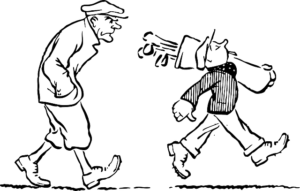What is a foil character? A foil character is a literary device used to create contrast. They often highlight the protagonist’s strengths or provide a different perspective on the story. Readers often underestimate foil characters, but they can be some of the story’s most compelling and complex characters.
This blog post will discuss the foil characters and why you need one in your story!
What is a foil character, and what do they do in a story?
The foil character is very different from the main character, or “protagonist.” The foil character highlights the strengths and weaknesses of the main character through their interactions.
The foil character is a very complex and fascinating figure. On the surface, they seem shallow and selfish, but as you get to know them better, you realize that there is more to them than meets the eye. They are quite smart and calculating, and they have a lot of hidden depths.
One thing that makes them so fascinating is their ability to change their persona depending on who they are talking to. They can be sweet and loving one minute and vicious and cruel the next, which makes it very difficult to trust them or know what they want.
The foil is a very versatile character. They can be played as light or dark characters and used for severe or comic scenes. To play foil, they must be very good at reacting to the other actor and providing contrast.
How can foil characters be used to create contrast?

For example, if the main character is outgoing and impulsive, the foil character might be introverted and more thoughtful. The foil character brings out different aspects of the main character’s personality, making the story more interesting.
Why do you need a foil character in your story?
Foil characters are important because they can help to develop the main character and create conflict. Without foil characters, the story might be boring or lack tension.
How to create a foil character for your writing
There are a few things to consider when creating a foil character for your story
– First, think about the personality of the main character. What qualities do they have that you want to highlight? Then, create a character with opposite or contrasting qualities. For example, if your main character is brave and impulsive, you might create a foil character who is more reserved and cautious.
– It’s also important to consider how the foil character will interact with the main character. Will they be friends or enemies? How will their relationship change over time?
One example could be:
The foil character will challenge the main character in some way, providing a different perspective that helps the main character grow. For example, the foil might be more ambitious and push the main character to work harder, or the foil might be more cautious and help the main character avoid making mistakes.
– Finally, consider what role the foil character will play in the story. Will they be a major supporting character or a minor figure?
The foil character is often the antagonist in the story, but can also play other roles such as a friend or mentor to the protagonist. For example, in The Hunger Games, Haymitch is a foil character to Katniss because while he is a drunk, she is determined. He helps her when he can, but ultimately wants her to fail so that he can have someone to bet on in the games.
The benefits of using a foil character in your writing

When used effectively, foil characters can add great depth and complexity to your story. They can provide an important contrast to your main character, highlighting their strengths and weaknesses.
Foil characters can also help to create tension and conflict, driving the story forward. And you can use them to surprise and engage readers, keeping them hooked until the end.
Here are some tips on how to use foil characters in your writing:
– To create the most effective contrast, choose a foil character who is as different from your main character as possible. If your protagonist is shy and introverted, their foil might be extroverted and outgoing. If your protagonist is a young child, their foil could be an adult.
– A good foil character will help to highlight your protagonist’s strengths and weaknesses. For example, if your main character is impulsive and rash, their foil might be calm and level-headed.
– You can use a foil character to deepen your protagonist’s backstory. For example, if your main character was orphaned at a young age, their foil could be someone from a loving family.
– You can use a foil character to create conflict. For example, if your main character is a peace-loving pacifist, their foil could be a war-mongering general.
– You can use a foil character to add depth to your story. For example, if your main character is a bit one-dimensional, their foil could be a rich and complex individual.
– You can use a foil character to create tension. For example, if your main character is a bit of a doormat, their foil could be an overbearing bully.
– You can use a foil character to make your story more interesting. For example, if your main character is a bit bland, their foil could be a colorful and vivid individual.
– You can use a foil character to add conflict. For example, if your main character is a bit of a pushover, their foil could be a contentious individual.
– You can use a foil character to create suspense. For example, if your main character is a bit predictable, their foil could be a wild card.
– You can use a foil character to add humor. For example, if your main character is a bit dry, their foil could be a goofy and fun-loving individual.
Examples of famous foil characters from literature and film

Now that we’ve gone over what a foil character is and why you need one let’s look at some examples of foil characters from literature and film.
– Sherlock Holmes and Dr. Watson from the Sherlock Holmes stories by Arthur Conan Doyle are classic examples of a foil character relationship. Sherlock is a brilliant detective who uses his deductive reasoning skills to solve crimes, while Watson is a more down-to-earth doctor who often acts as Sherlock’s sounding board.
– In the Harry Potter series, Hermione Granger is a foil for both Harry and Ron. She is a brilliant witch who always gets top marks in her classes, while Harry and Ron focus more on defeating Voldemort.
– In The Dark Knight, Harvey Dent is a foil for Batman. Dent is a crusading district attorney who wants to clean up Gotham City, while Batman is a vigilante willing to break the law to get results.
– In the T.V. show Breaking Bad, Jesse Pinkman is a foil for Walter White. Jesse is a former meth cook trying to make things right, while Walter is a high school chemistry teacher who has turned to cook meth to make money.
A foil character contrasts with the main character to highlight their qualities. You can use it to show how the main character has changed over the story or to provide a different perspective on the story’s events.
Some stories will have multiple foil characters, each serving a different purpose. For example, in the movie The Dark Knight Rises, both Catwoman and Bane are foils for Batman. Catwoman is someone who is trying to help Batman, while Bane is someone who is trying to destroy him.
Foil characters help to develop the story and the characters within it. They can provide comic relief or act as a sounding board for the main character. Without foil characters, many stories would be much less interesting.
How to use a foil character to create tension and conflict in your story

One of the essential functions of a foil character is to create tension and conflict within the story. A foil character can highlight the protagonist’s flaws or show how different two people can be.
– For example, in the movie The Social Network, Mark Zuckerberg is the foil for Eduardo Saverin. Saverin is more emotional, and Zuckerberg is more logical, which creates tension between the two characters and leads to conflict.
– In the book The Catcher in the Rye, Holden Caulfield is the foil for his brother, D.B. Caulfield is a successful writer, and Holden is a troubled teenager. This foil highlights the conflict between Holden’s desire for innocence and D.B.’s success in the adult world.
Foil characters can be used to create tension and conflict and to highlight the flaws of the protagonist. When used effectively, they can make a story more interesting and complex.
The danger of creating a one-dimensional foil character
One of the dangers of creating a foil character is that they can become one-dimensional and unbelievable. If a foil character is too perfect or too evil, they can seem like caricatures. It’s important to create foil characters that are believable and three-dimensional.
The need for balance between the protagonist and the foil character
Another danger of foil characters is that they can overshadow the protagonist. For a foil character to be effective, there must be a balance between the two characters. The foil character should highlight the protagonist’s qualities without taking away from the story.
Conclusion
A foil character is an essential tool for any writer. By understanding how to create and use a foil character, you can add depth and dimension to your story. Designing believable foils will help your readers become fully invested in your characters and their journey. With careful consideration, you can use a foil character to improve your story’s overall tension and conflict.
In what ways could you use a foil character in your writing? Please share your thoughts with us in the comments below!
If you’re working on your first novel and are looking for more help with your writing, please check out my other writing articles at https://ullahakanson.com/blog/
I hope you’ll have fun creating this character!
All the best,
Ulla

